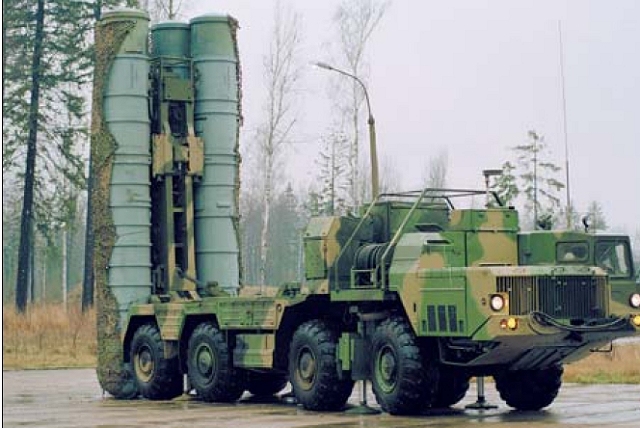3z000z-24
لـــواء


الـبلد : 
المهنة : طآلب
المزاج : رآيق على طول
التسجيل : 18/04/2011
عدد المساهمات : 3501
معدل النشاط : 3811
التقييم : 333
الدبـــابة : 
الطـــائرة : 
المروحية : 


|  موضوع: صفقه S-300 PMU1 للاردن والكويت (صفقه غير موكده) موضوع: صفقه S-300 PMU1 للاردن والكويت (صفقه غير موكده)  السبت 17 ديسمبر 2011 - 2:50 السبت 17 ديسمبر 2011 - 2:50 | |
|  | تم تصغير هذه الصورة. إضغط هنا لرؤية الصورة كاملة. الحجم الأصلي للصورة هو 640 * 428. |

The Russian S-300PMU-1 TMD System
The proliferation of ballistic and cruise missiles has created interest in theater missile defense (TMD). The objective of a TMD system is to defend against missile attacks. Such a system might be configured to protect an area as small as a city or port, or as large as several thousand square kilometers. It could provide protection for civilian populations as well as military forces. Providing effective TMD would require a seamless network of early warning sensors, command posts, fire-control radars, and anti-missile missiles.
Although defensive in nature, the deployment of a TMD system may catalyze threats to international peace and security by upsetting a regional balance of military forces, undercutting other states' deterrent capabilities, or by protecting forces that can be used for offensive purposes. TMD deployment may therefore spur an unstable offense-defense arms race for relative advantage, undermine the prospects for arms control, and exacerbate political conflicts between rival states.
The Russian S-300PMU-1 (NATO designation SA-10d �Grumble�) TMD system that is being sold to Cyprus is a much-improved version of the S-300P first developed by the Russian Almaz Scientific Production Association in 1967. The S-300P was designed as a strategic air-defense system for use against low-altitude air-breathing targets, such as cruise missiles and aircraft. Earlier generations of Soviet air-defense systems were used to shoot down the U-2 spy plane flown by Francis Gary Powers over the Soviet Union in 1960, and were used extensively by North Vietnamese air defenses against US aircraft in the 1960s and 1970s.
The S-300PMU-1 is the third generation of the S-300P missile lineage, and has additional capability to engage ballistic missiles as well as cruise missiles and aircraft. It has been in service with the Soviet and then Russian air forces since the early 1990s, and was first publicly displayed at the 1992 Moscow Air Show. The letter "P" designates podvizhnyy or mobile, "M" indicates modifitsirovannyy or modified, "U" is for usovershenstvovannyy or improved, and the "-1" upgrade incorporates advanced technologies and software as well as a new missile variant. Some elements of the S-300PMU-1 system may have an "Eh" or "E" suffix in their designation, if they are for eksportnyy or export.
A ground-based TMD system typically would be composed of one or more firing batteries of missile launchers, deployed in conjunction with surveillance radar, engagement radar, and a command-and-control unit.
An S-300PMU-1 firing battery can comprise up to forty-eight 48N6 missiles on twelve self-propelled 5P85S 8x8 transporter-erector-launcher vehicles (TELs), each TEL carrying four missiles in sealed canisters. An alternative to the 5P85S TEL is the 5P85T launcher-trailer, which is towed by the KRAZ-260 truck-tractor. Launch data and initial guidance for the missiles is provided by a 36N85 (export designation 30N6E1) vehicle-mounted engagement radar, which has three scanning modes for engaging aircraft at ranges between 3�5km and 150km, and for engaging ballistic missiles to a maximum range of 40km. The 36N85 engagement radar can guide up to twelve 48N6 surface-to-air missiles (SAMs) to simultaneously engage up to six different targets. The engagement radar can also be mounted on the 40V6 extendable tower, for improved tracking of low-flying cruise missiles or aircraft. Additional equipment for the battery may include a survey vehicle to prepare the launchsite and vehicles to transport additional missiles. Deployment time for an S-300PMU-1 battery is said to be five minutes.
Command, control, and communications (C3) for up to six S-300PMU-1 firing batteries � which together form an air-defense battalion � is provided by the Almaz 83M6 control system, which coordinates the activities of the firing batteries and links the surveillance radar with a higher level of command. The 83M6 C3 system includes a 54K6 command-post vehicle, and a 64N6 three-dimensional, long-range surveillance radar mounted on a semi-trailer. The 64N6 (NATO designation �Tombstone�) radar can detect and track targets in normal, cluttered, and severe electronic countermeasures environments. Data are relayed from the radar to the 54K6 command post for processing and assessment. The command post then assigns the optimal battery to launch missiles to attack the target. The 64N6 radar�s detection range is 300km for targets travelling up to 2.78 km/s. The 86M6 control system reportedly can acquire, identify, and track up to 100 targets.
The S-300PMU-1 system uses the 1,900kg 48N6 medium-range missile, which can engage targets at ranges of 5-150km, and at altitudes between 10m and 27,000m. The single-stage, solid fuel 48N6 missile has a 143kg high-explosive fragmentation warhead, and an S-300PMU-1 battery can launch one missile every three seconds. The 48N6 missile can reportedly withstand up to 20 lateral Gs and intercept targets traveling at speeds up to 2.78 km/s.
The Russian contract with Cyprus to supply the S-300PMU-1 has not been made public, and reports conflict on how many batteries Cyprus has purchased. Russian news media speculate that the contract includes the delivery and deployment of three batteries, with each battery including 12 launchers. A source close to the Russian military leadership said the contract includes one battery comprised of 20 or 24 launchers. Turkish military experts reportedly believe that Cyprus purchased 24 launchers, while Greek news media say that Cyprus has purchased three S-300PMU-1 batteries. MIT Center for International Studies analyst Dan Lindley estimates that Russia has sold "perhaps eight to twelve S-300 surface to air systems to Cyprus." The Sunday Times of London reports that Cyprus has ordered "up to 70 missiles from the Russians, with as many as 12 mobile launchers." In 1994, the State Committee of the Russian Federation for the Defense Industry reported that the purchase price of an S-300PMU-1 system was $91 million. This figure and the estimated $400�600 million value of the Cyprus contract suggests that Cyprus has purchased between four and six S-300PMU-1 firing batteries. Steven Zaloga, a senior analyst with the Teal Group and correspondent for Jane�s Intelligence Review, reported that "The size of the order has not been disclosed but is probably only a few firing batteries." It is not clear whether Cyprus is acquiring C3 components and hence the overall effectiveness of the batteries is uncertain.
The Russian arms export agency Rosvoorouzhenie is marketing the 300PMU-1 internationally as a competitor to the MIM-104 Patriot air-defense missile system produced by the US firms Raytheon and Lockheed Martin. There are conflicting reports regarding which countries have acquired the S-300P system, probably due in part to the numerous versions developed and designations used for the S-300P since its development began in 1967. Jane's Missiles and Rockets reported in 3/98 that the S-300 series has been exported to Belarus, Bulgaria, China, the former East Germany, Kazakhstan, Poland, Slovenia, and possibly to Croatia, Hungary, and the Ukraine. Jane�s Land-Based Air Defence 1997-98 reports that Belarus, China, Croatia, Hungary, Slovakia, and Ukraine all have versions of the S-300P in service in their armed forces. According to Jane�s Strategic Weapons Systems Issue 24, the S-300P has been exported to Belarus, Bulgaria, China, Croatia, Czech Republic, Iran, Slovakia, Syria, and Ukraine. It also states that there are unconfirmed reports of the S-300P being exported to Bosnia, Hungary, Jordan, and Kuwait. According to a 5/12/95 report in the Russian newspaper Nezavisimaya gazeta, Iran was considering purchasing the S-300PMU-1. According to an 8/29-9/4/97 report in the Russian weekly Nezavisimoye voyennoye
obozreniye, the S-300PMU-1 is in the inventory of several former Warsaw Pact countries, members of the Commonwealth of Independent States, and China.
المصدر 
http://cns.miis.edu/cyprus/s300tdms.htm |
|
الطير الحر
لـــواء


الـبلد : 
التسجيل : 25/06/2011
عدد المساهمات : 2832
معدل النشاط : 2897
التقييم : 310
الدبـــابة : 
الطـــائرة : 
المروحية : 

|  موضوع: رد: صفقه S-300 PMU1 للاردن والكويت (صفقه غير موكده) موضوع: رد: صفقه S-300 PMU1 للاردن والكويت (صفقه غير موكده)  السبت 17 ديسمبر 2011 - 8:07 السبت 17 ديسمبر 2011 - 8:07 | |
| نظام ال S-300 انتهى توقف انتاجه برجى الانتظار من 5 الى 10 سنوات S-400 هذا إذا قبلت روسيا بيعه |
|
Dr Isa
field marshal


الـبلد : 
العمر : 44
المهنة : طبيب
المزاج : متقلب
التسجيل : 26/12/2010
عدد المساهمات : 15047
معدل النشاط : 11005
التقييم : 573
الدبـــابة : 
الطـــائرة : 
المروحية : 

|  موضوع: رد: صفقه S-300 PMU1 للاردن والكويت (صفقه غير موكده) موضوع: رد: صفقه S-300 PMU1 للاردن والكويت (صفقه غير موكده)  الأربعاء 21 ديسمبر 2011 - 18:12 الأربعاء 21 ديسمبر 2011 - 18:12 | |
| الخبر قديم جدا , منذ التسعينيات |
|